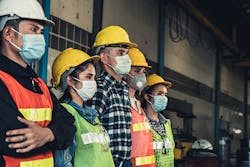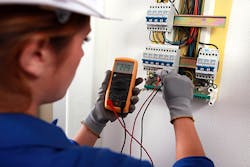New safety tech: Know your potential hazards and get prepared
To turn a phrase, keep your safety measures close and your awareness of perils closer. To know your possible hazards and to prepare in every way possible are the first two steps of safety. Investment in innovation is a third.
The safety measures that manufacturers typically have in place help them be specially prepared to take precautions for the COVID-19 pandemic. Continuous training of most plant workers creates an environment of being informed and ready for anything.
“I’m proud to be a part of a company that is not only taking the right steps,” says Nick Schiltz of Grace Engineered Products, Inc. “We have been ready for an emergency like this for a long time. For example, we’ve worn face masks for health safety for years.”
Investment in safety pays off in the health of workers and with a financial return. “For every dollar invested in safety and health programs,” says OSHA’s Office of Regulatory Analysis, “companies can expect a return of four to six dollars.”
Risk assessments
The U.S. Bureau of Statistics (BLS) Census of Fatal Occupational Injuries shows that in 2018 (the latest numbers available) there was a total of 343 workplace fatalities in U.S. manufacturing facilities, a jump of 13% from 2017, with a total of over 100,000 injuries per year. Accidents in plants occur for many reasons: ill-maintained equipment; workers disregarding safety training and procedures (such as a worker straddling a twin step ladder to reach a lathe); absence of proper machine guards and personal protective equipment (PPE), no lockout/tagout procedures and lack of other electrical precautions; deficient training for using forklifts, platform lifts, and hand trucks; inadequate fall safeguards; and insufficient hearing and head protection.
“Our assessments identify all of these factors, and disrupt standard operating procedures that may hold inherent, yet unidentified risks,” says Matt Block, Director of Health and Safety Services at Magid Glove & Safety, a manufacturer of 70 plus years in Romeoville, IL.
Where there are dangers, there are solutions – new technology, PPE gear, and other control measures. With that in mind, it is essential to make thorough and professional risk assessments of a plant, deep-dive reviews to identify hazardous signs. Beyond creating high-quality gloves for their manufacturing customers, Magid provides OSHA-ready safety assessments for their customers that average 100 plus pages.
Block gives the example of a customer, a tier-one automotive parts supplier who needed to address their injury rates (first aid and recordable). Magid performed assessments at 19 of this company’s facilities in North America – U.S., Canada, and Mexico – and found inconsistent PPE solutions across the corporation. The company reduced injuries over 32% overall by implementing Magid’s recommendations of hand, arm, head, eye protection as well as protective clothing. This included longer lasting gloves: 63 hours of use per pair vs. 4.1 hours, with a savings of about 80% as gloves account for the highest percentage of spend for most personal protective equipment programs.
“This example is not unique,” asserts Block. “When we work with our customers with a common goal, we can typically achieve injury reductions in the range of 50% with double-digit savings.”
Voltage portals and redundant LED indicators
In 2019 the LOTO Standard 29 CFR 1910.147 “Control of Hazardous Energy” placed fourth in OSHA’s Top Ten list of most-cited violations with a total of 2,975 violations. The companies in this list of violations failed to establish an energy control procedure partially or not at all, did not provide sufficient employee training or conduct periodic evaluations of procedures, and did not use LOTO devices or equipment.
Since 2014, OSHA has issued more than 10,000 LOTO citations. These companies not only paid penalties for these violations, but these preventable workplace incidents cost these companies millions of dollars in lost productivity, medical expenses, and insurance costs.
With the available resources and technology today, these accidents and costs should be declining. Instead, in recent years these violations have increased with employers failing to comply with the minimum performance requirements even though there are an estimated 120 fatalities and 50,000 injuries per year that could be prevented with LOTO.
The idea of Grace Engineered Products, Inc. began when in 1993 a client asked them to address an electrical hazard in a friction welder retrofit project. The founder, Phil Allen, designed what became GracePort Panel Interface Connectors to remove the risks between the PLC and the operator. Grace then tackled the high LOTO violations.
Grace Engineered Products, Inc. created their Permanent Electrical Safety Devices (PESDs), a line of voltage portals and redundant LED indicators. This includes their Safe-Test Point voltage indicator with bright LED lights that blink when energized and the Voltage Test Station, a combination of electrical and mechanical LOTO. These products go steps further than what is required by the NFPA 70E and OSHA standards to provide a high impedance protected method of validating voltage presence or absence.
For example, one Grace customer, a U.S. steel manufacturer, had at least two incidents where employees forgot to check or couldn’t see the power indicator lights, and therefore, connected and disconnected crane magnet connectors while energized. There was one injury from an arc flash that caused 2nd- and 3rd-degree burns, and the other a slight shock. Grace installed PESDs at the plant, preventing any further LOTO user errors and saving time on LOTO tasks.
Grace recently conducted a survey of their 17,000 existing customers. Of the 800 respondents, the survey found that PESD users reduced electrical LOTO tasks an average of 20 minutes and reduced mechanical LOTO tasks by an average of 23 minutes. Using these tools, Grace customers also reported a reduction from a typical 1-hour, 2-person LOTO operation to a 5-minute, 1-person procedure.
IIoT continuous temperature monitoring devices
Another electrical hazard is unpredictable failures in key components such as circuit breakers, busbars, and other terminations. This is particularly true with old electrical power distribution equipment where a problem is often discovered only when there is overheating of contacts, frequent breaker tripping, and breaker failures which sometimes cost millions of dollars.
Of course, by the time this happens, the excess heat can damage equipment and disrupt plant productivity and uptime. Many facilities use periodic monitoring tools such as IR thermography inspections. However, these tools do not provide real-time temperature data and are usually performed only once a year.
A company can solve these issues with smart IIoT continuous temperature monitoring devices. Grace offers the GraceSense Hot Spot Monitor, part of their Predictive Maintenance System suite of continuous asset health monitoring technology. The Hot Spot Monitor diagnoses the cause of breaker failures and identifies potential failure points, thus avoiding unplanned outages, service interruptions, and equipment failures.
GraceSense continuously monitors the temperature data and integrates the data in a plant-wide SCADA system. (The fiber optic technology can be installed in any electrical system.) Personnel can look at historical data for unexplained temperature spikes and make operational changes to sequence the load, reduce the inrush currents, and manage harmonics.
IIoT PPE wearables
“Our platform gives the industry a real-time understanding of their workforce and why accidents happen,” Saikat Dey, CEO and co-founder of GuardHat. “What is the first thing you ask when someone calls to tell you they are hurt: ‘Where are you? How are you? Are you OK? Can you get to a place of safety?’ ”
In 2014, a group of entrepreneurs in the heavy industry sector saw a need to bridge the last mile between wearable PPE and enterprise systems. They identified an opportunity to provide a safety solution particularly in industries with high-risk occupational hazards and highly mobile workers but with limited connectivity (no WiFi or cellular networks, for example).
They created GuardHat, an end-to-end proprietary, purpose-built IoT system for situational awareness in real time. The GuardHat platform can locate sensors, assets, and individuals with a custom-built real-time location system (RTLS) geolocation software that provides sub-meter locational accuracy. In 2019 Frost & Sullivan recognized GuardHat with their Best Practices Award for “Connected Safety in North America, Company of the Year.”
As Frost & Sullivan wrote, “GuardHat systems alert individuals to dangerous areas, nearby equipment operation, and security restricted zones. Rather than relying on traditional radios, GuardHat systems utilize a peer-to-peer network, enabling real-time communication between individuals, connected assets, and a central hub – all in an effort to prevent accidents, improve response times/productivity, and unlock a universe of Big Data potential.” It is important to note that their platform integrates with other hardware, with any connectable sensor, and with a variety of third-party platforms.
In the event of a fall, exposure to toxic gases, lockout zones, proximity to moving equipment, etc., the system sends real-time alerts to both the user and supervisor. This insight gives operators and on-site workers a deeper understanding of how people and assets interact and creates better decision-making in the facility. GuardHat adds an agile IoT component (i.e., to link a form factor such as a mobile application, hardhat, or tags) to continuously monitor the workers’ location, condition, and immediate environment.
Guardhat takes this data from a range of connected sensors, devices, and wearable data sources to an in-house developed control center platform. KYRA, as this platform is called, ties together multi-modal data from disparate elements and formats into a single analytics engine. It reads a worker’s mobility, position, floor level, proximity, and relationship to people and assets. KYRA then processes these a massive amount of data (geo-stamped and time-tagged with event information) to present a single, human-centric view and status assessment on a single screen.
“We’re like the ‘Intel Inside’ of PPE. Users have been looking for this technology,” adds Dey, “We’ve embedded product in 10 companies such as a Fortune 100 mining services company, the largest nuclear power player, and a leading chemical player.”
Deanna Nord, owner of Nord Strategy Group, is a writer, public speaker, and creative strategist. Contact her at [email protected].


